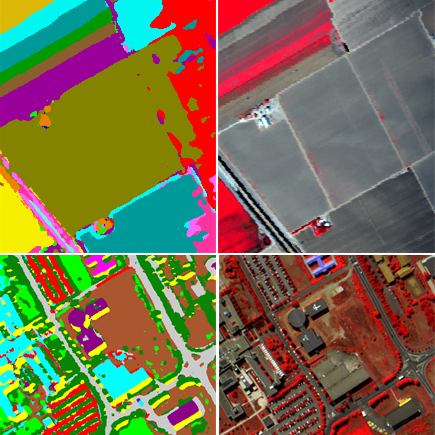Awesome
MDL4OW
Source code and annotations for :
Shengjie Liu, Qian Shi, and Liangpei Zhang. Few-shot Hyperspectral Image Classification With Unknown Classes Using Multitask Deep Learning. IEEE TGRS, 2020. doi:10.1109/TGRS.2020.3018879
Contact: sjliu.me@gmail.com
Code and annotations are released here, or check https://github.com/sjliu68/MDL4OW
Overview
Ordinary: misclassify road, house, helicopter, and truck
Below is a normal/closed classification. If you are familiar with hyperspectral data, you will notice some of the materials are not represented in the training samples. For example, for the upper image (Salinas Valley), the road and the houses between farmlands cannot be classified into any of the known classes. But still, a deep learning model has to assign one of the labels, because it is never taught to identify an unknown instance.

What we do: mask out the unknown in black
What we do here is, by using multitask deep learning, enpowering the deep learning model with the ability to identify the unknown: those masked with black color. For the upper image (Salinas Valley), the roads and houses between farmlands are successfully identified. For the lower image (University of Pavia Campus), helicopters and trucks are successfully identified.

Key packages
tensorflow-gpu==1.9
keras==2.1.6
libmr
Tested on Python 3.6, Windows 10
Recommend Anaconda, Spyder
How to use
Hyperspectral satellite images
The input image is with size of imx×imy×channel.
The satellite images are standard data, downloaded here: http://www.ehu.eus/ccwintco/index.php/Hyperspectral_Remote_Sensing_Scenes
The above data is in matlab format, the numpy format can be found here (recommended): https://drive.google.com/file/d/1cEpTuP-trfRuphKWqKHjAaJhek5sqI3C/view?usp=sharing
Quick usage
python demo_salinas.py
Arguments
--nos: number of training samples per class. 20 for few-shot, 200 for many-shot
--key: dataname: 'salinas', 'paviaU', 'indian'
--gt: gtfile path
--closs: classification loss weight, default=50 (0.5)
--patience: if the training loss does not decrease for {patience} epoches, stop training
--output: save path for output files (model, predict probabilities, predict labels, reconstruction loss)
--showmap: save classification map
Evaluation code update on 18 May 2021
When using the evaluation code "z20210518a_readoa.py", you should change the parameter "mode" for different settings. The inputs are output files from the training script.
Mode
mode==0: closed-set
mode==1: MDL4OW
mode==2: MDL4OW/C
mode==3: closed-set with probablity
mode==4: softmax with threshold
mode==5: openmax